YAMAHA SUV 1200 2001 Owners Manual
Manufacturer: YAMAHA, Model Year: 2001, Model line: SUV 1200, Model: YAMAHA SUV 1200 2001Pages: 135, PDF Size: 21.67 MB
Page 91 of 135
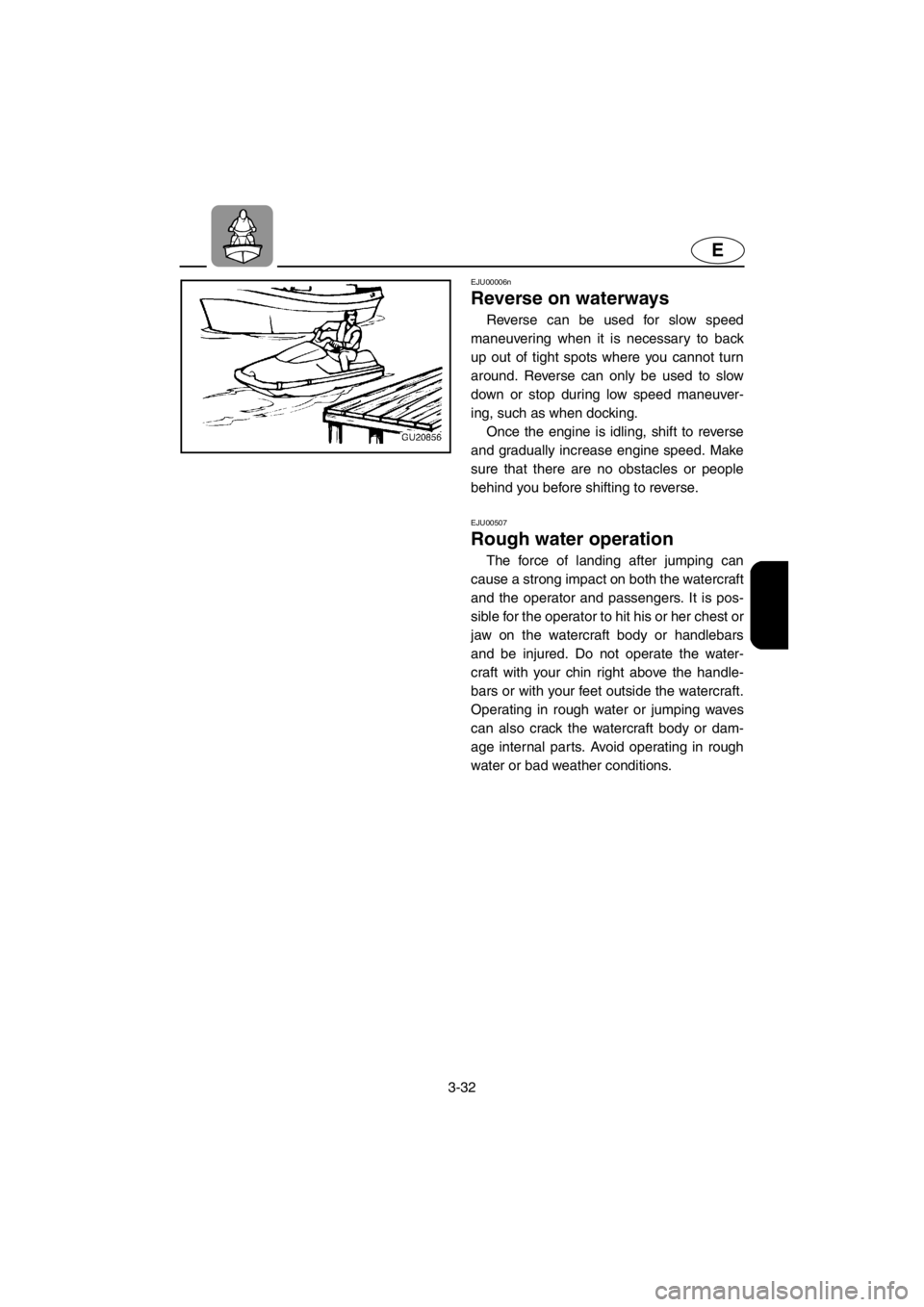
3-32
E
EJU00006n
Reverse on waterways
Reverse can be used for slow speed
maneuvering when it is necessary to back
up out of tight spots where you cannot turn
around. Reverse can only be used to slow
down or stop during low speed maneuver-
ing, such as when docking.
Once the engine is idling, shift to reverse
and gradually increase engine speed. Make
sure that there are no obstacles or people
behind you before shifting to reverse.
EJU00507
Rough water operation
The force of landing after jumping can
cause a strong impact on both the watercraft
and the operator and passengers. It is pos-
sible for the operator to hit his or her chest or
jaw on the watercraft body or handlebars
and be injured. Do not operate the water-
craft with your chin right above the handle-
bars or with your feet outside the watercraft.
Operating in rough water or jumping waves
can also crack the watercraft body or dam-
age internal parts. Avoid operating in rough
water or bad weather conditions.
E_GU5-71-3.fm Page 32 Thursday, July 13, 2000 7:52 PM
Page 92 of 135
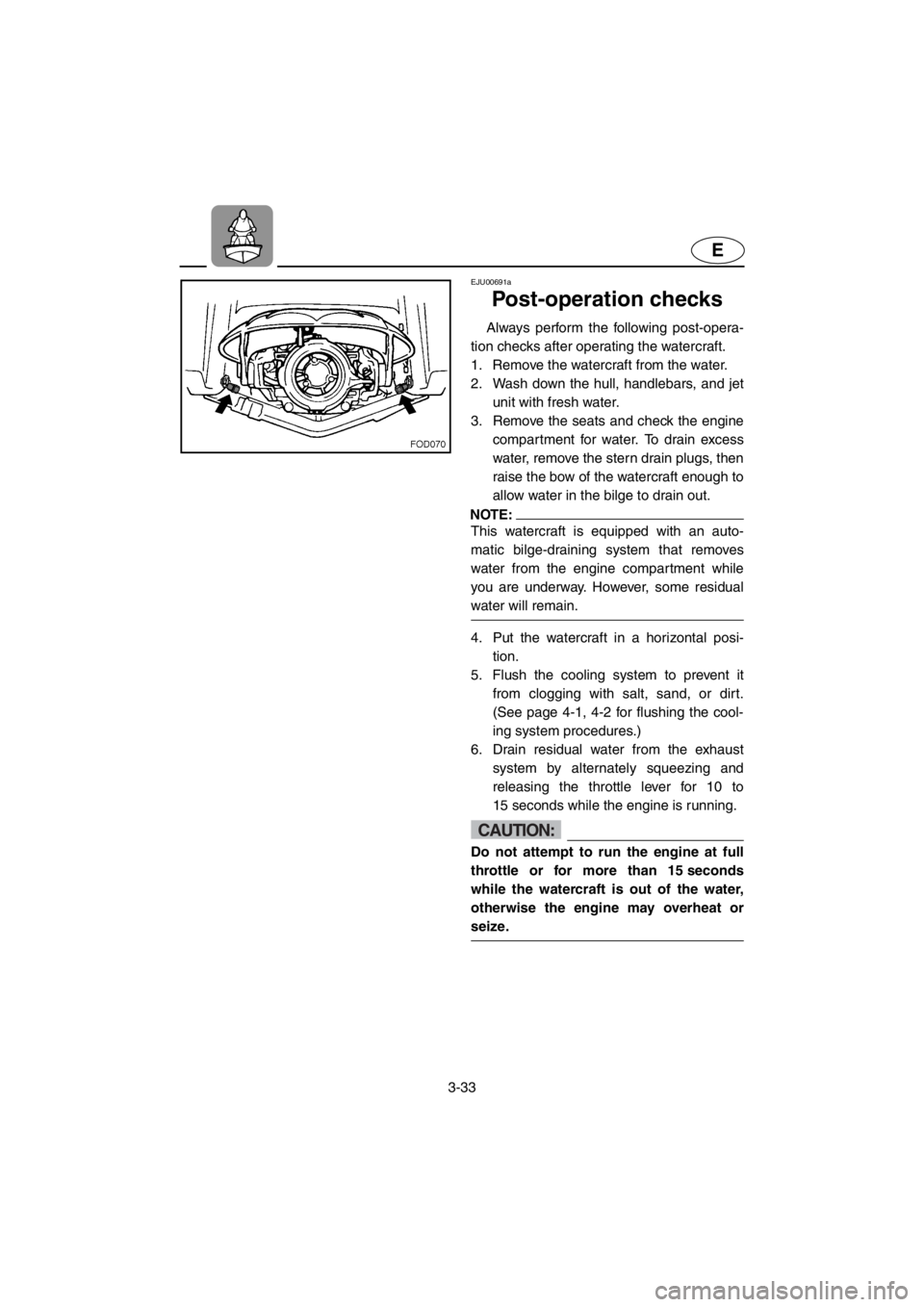
3-33
E
EJU00691a
Post-operation checks
Always perform the following post-opera-
tion checks after operating the watercraft.
1. Remove the watercraft from the water.
2. Wash down the hull, handlebars, and jet
unit with fresh water.
3. Remove the seats and check the engine
compartment for water. To drain excess
water, remove the stern drain plugs, then
raise the bow of the watercraft enough to
allow water in the bilge to drain out.
NOTE:
This watercraft is equipped with an auto-
matic bilge-draining system that removes
water from the engine compartment while
you are underway. However, some residual
water will remain.
4. Put the watercraft in a horizontal posi-
tion.
5. Flush the cooling system to prevent it
from clogging with salt, sand, or dirt.
(See page 4-1, 4-2 for flushing the cool-
ing system procedures.)
6. Drain residual water from the exhaust
system by alternately squeezing and
releasing the throttle lever for 10 to
15 seconds while the engine is running.
CAUTION:
Do not attempt to run the engine at full
throttle or for more than 15 seconds
while the watercraft is out of the water,
otherwise the engine may overheat or
seize.
E_GU5-71-3.fm Page 33 Thursday, July 13, 2000 7:52 PM
Page 93 of 135
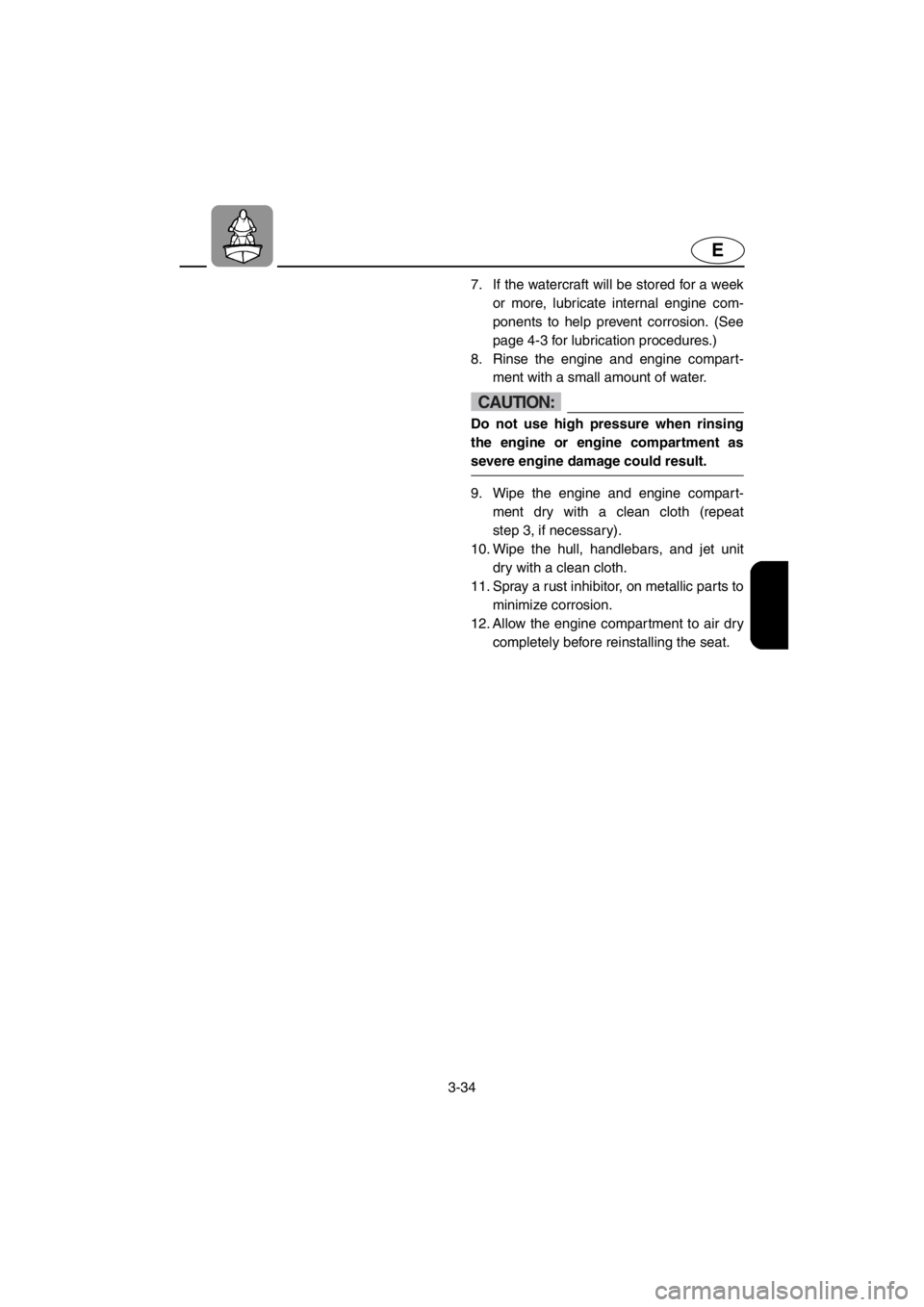
3-34
E
7. If the watercraft will be stored for a week
or more, lubricate internal engine com-
ponents to help prevent corrosion. (See
page 4-3 for lubrication procedures.)
8. Rinse the engine and engine compart-
ment with a small amount of water.
CAUTION:
Do not use high pressure when rinsing
the engine or engine compartment as
severe engine damage could result.
9. Wipe the engine and engine compart-
ment dry with a clean cloth (repeat
step 3, if necessary).
10. Wipe the hull, handlebars, and jet unit
dry with a clean cloth.
11. Spray a rust inhibitor, on metallic parts to
minimize corrosion.
12. Allow the engine compartment to air dry
completely before reinstalling the seat.
E_GU5-71-3.fm Page 34 Thursday, July 13, 2000 7:52 PM
Page 94 of 135
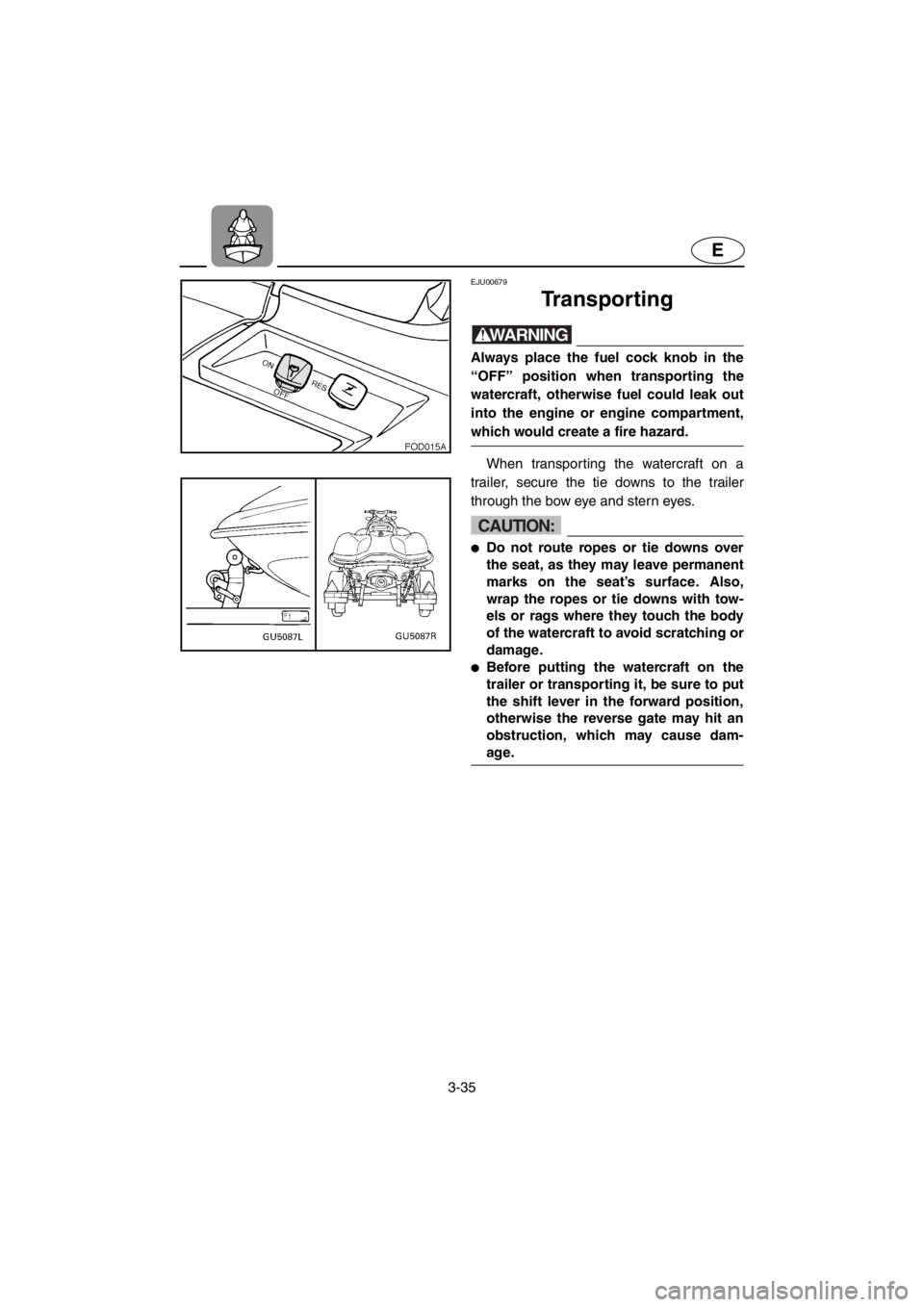
3-35
E
EJU00679
Transporting
WARNING
Always place the fuel cock knob in the
“OFF” position when transporting the
watercraft, otherwise fuel could leak out
into the engine or engine compartment,
which would create a fire hazard.
When transporting the watercraft on a
trailer, secure the tie downs to the trailer
through the bow eye and stern eyes.
CAUTION:
●Do not route ropes or tie downs over
the seat, as they may leave permanent
marks on the seat’s surface. Also,
wrap the ropes or tie downs with tow-
els or rags where they touch the body
of the watercraft to avoid scratching or
damage.
●Before putting the watercraft on the
trailer or transporting it, be sure to put
the shift lever in the forward position,
otherwise the reverse gate may hit an
obstruction, which may cause dam-
age.
E_GU5-71-3.fm Page 35 Thursday, July 13, 2000 7:52 PM
Page 95 of 135
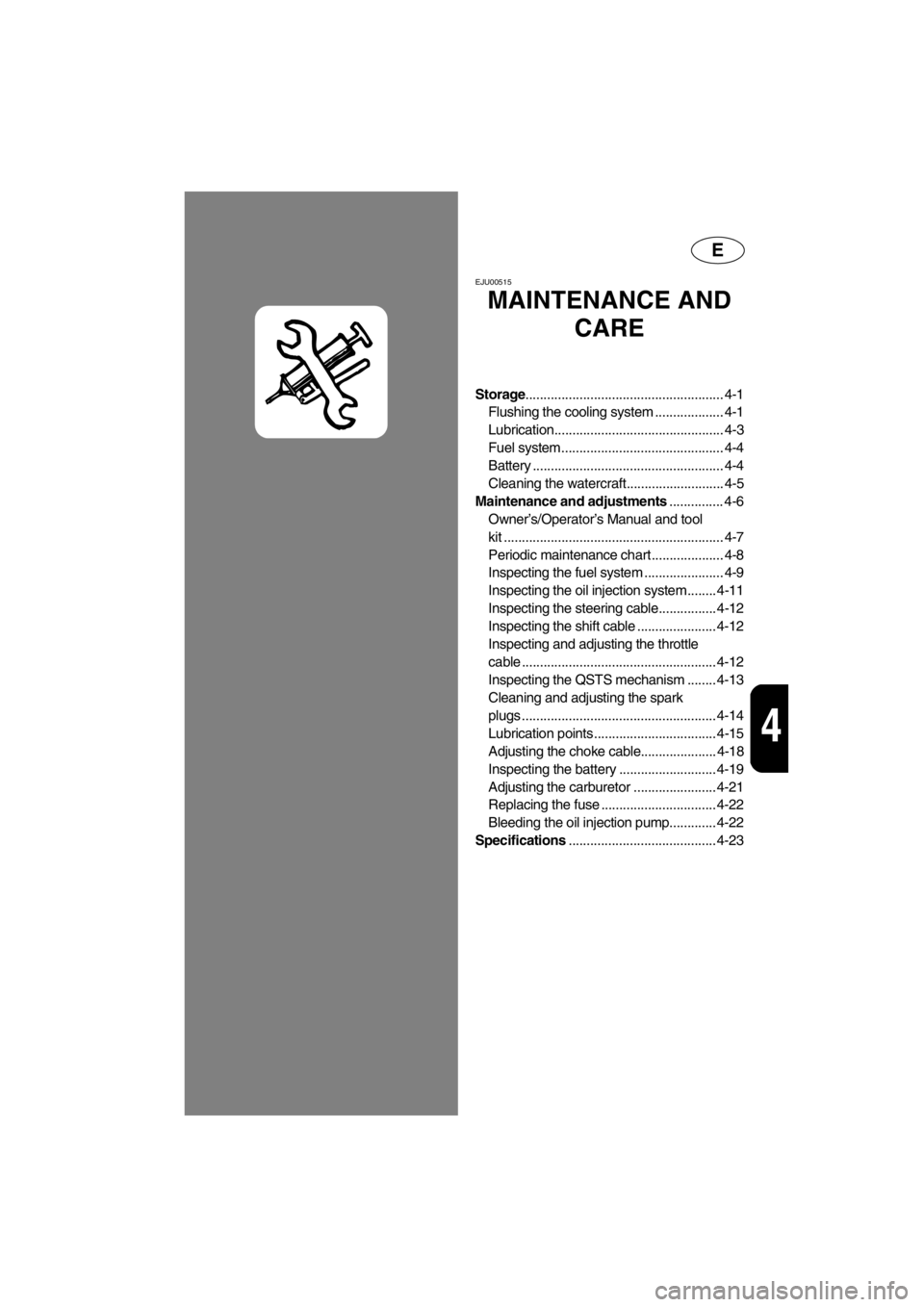
E
4
EJU00515
MAINTENANCE AND
CARE
Storage....................................................... 4-1
Flushing the cooling system ................... 4-1
Lubrication............................................... 4-3
Fuel system............................................. 4-4
Battery ..................................................... 4-4
Cleaning the watercraft........................... 4-5
Maintenance and adjustments............... 4-6
Owner’s/Operator’s Manual and tool
kit ............................................................. 4-7
Periodic maintenance chart .................... 4-8
Inspecting the fuel system ...................... 4-9
Inspecting the oil injection system........ 4-11
Inspecting the steering cable................ 4-12
Inspecting the shift cable ...................... 4-12
Inspecting and adjusting the throttle
cable ...................................................... 4-12
Inspecting the QSTS mechanism ........ 4-13
Cleaning and adjusting the spark
plugs ...................................................... 4-14
Lubrication points .................................. 4-15
Adjusting the choke cable..................... 4-18
Inspecting the battery ........................... 4-19
Adjusting the carburetor ....................... 4-21
Replacing the fuse ................................ 4-22
Bleeding the oil injection pump............. 4-22
Specifications......................................... 4-23
E_GU5-71-4TOC.fm Page 1 Thursday, July 13, 2000 7:53 PM
Page 96 of 135
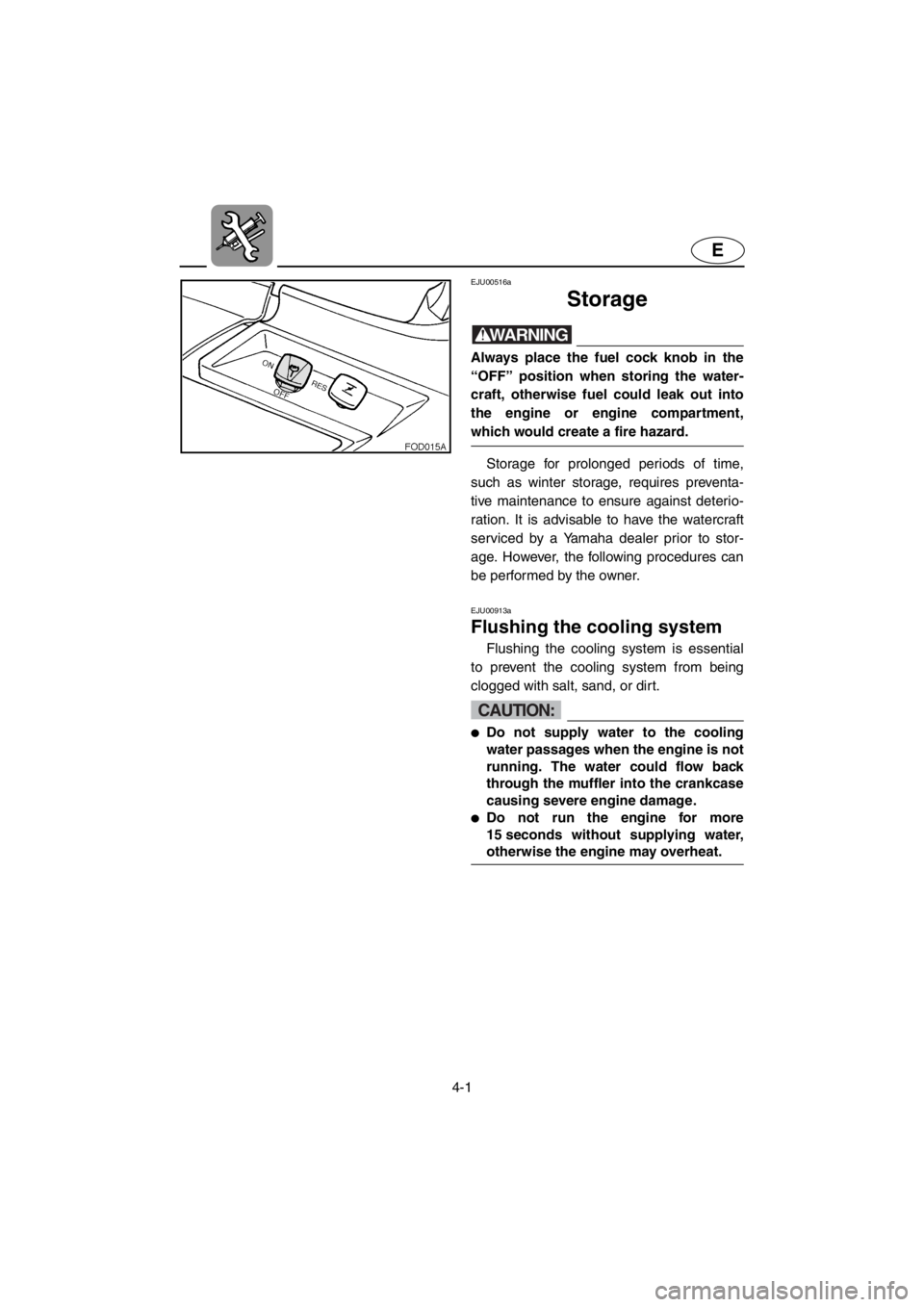
4-1
E
EJU00516a
Storage
WARNING
Always place the fuel cock knob in the
“OFF” position when storing the water-
craft, otherwise fuel could leak out into
the engine or engine compartment,
which would create a fire hazard.
Storage for prolonged periods of time,
such as winter storage, requires preventa-
tive maintenance to ensure against deterio-
ration. It is advisable to have the watercraft
serviced by a Yamaha dealer prior to stor-
age. However, the following procedures can
be performed by the owner.
EJU00913a
Flushing the cooling system
Flushing the cooling system is essential
to prevent the cooling system from being
clogged with salt, sand, or dirt.
CAUTION:
●Do not supply water to the cooling
water passages when the engine is not
running. The water could flow back
through the muffler into the crankcase
causing severe engine damage.
●Do not run the engine for more
15 seconds without supplying water,
otherwise the engine may overheat.
E_GU5-71-4.fm Page 1 Thursday, July 13, 2000 7:54 PM
Page 97 of 135
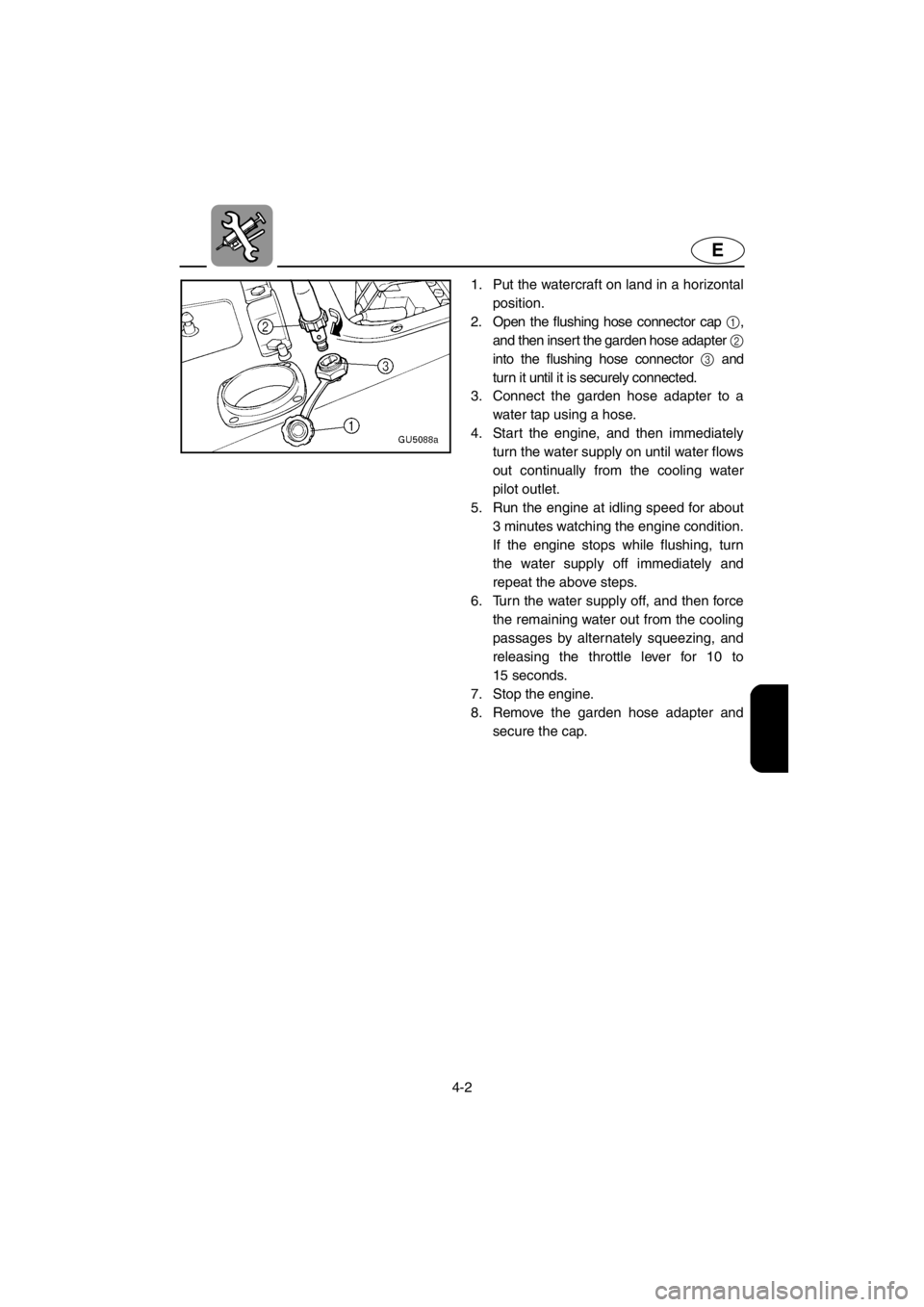
4-2
E
1. Put the watercraft on land in a horizontal
position.
2. Open the flushing hose connector cap 1,
and then inser t the garden hose adapter
2
into the flushing hose connector 3 and
turn it until it is securely connected.
3. Connect the garden hose adapter to a
water tap using a hose.
4. Start the engine, and then immediately
turn the water supply on until water flows
out continually from the cooling water
pilot outlet.
5. Run the engine at idling speed for about
3 minutes watching the engine condition.
If the engine stops while flushing, turn
the water supply off immediately and
repeat the above steps.
6. Turn the water supply off, and then force
the remaining water out from the cooling
passages by alternately squeezing, and
releasing the throttle lever for 10 to
15 seconds.
7. Stop the engine.
8. Remove the garden hose adapter and
secure the cap.
E_GU5-71-4.fm Page 2 Thursday, July 13, 2000 7:54 PM
Page 98 of 135
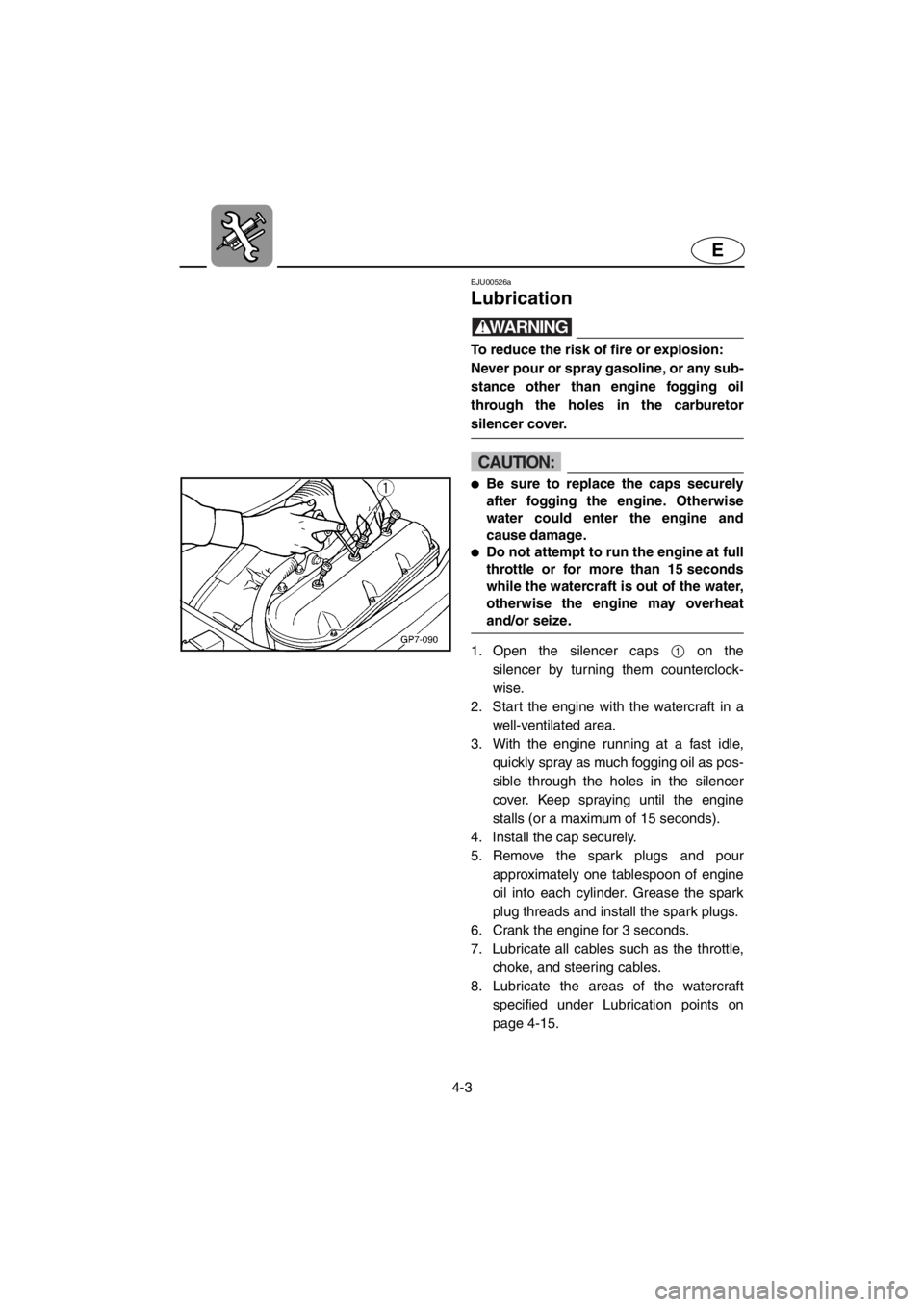
4-3
E
EJU00526a
Lubrication
WARNING
To reduce the risk of fire or explosion:
Never pour or spray gasoline, or any sub-
stance other than engine fogging oil
through the holes in the carburetor
silencer cover.
CAUTION:
●Be sure to replace the caps securely
after fogging the engine. Otherwise
water could enter the engine and
cause damage.
●Do not attempt to run the engine at full
throttle or for more than 15 seconds
while the watercraft is out of the water,
otherwise the engine may overheat
and/or seize.
1. Open the silencer caps 1 on the
silencer by turning them counterclock-
wise.
2. Start the engine with the watercraft in a
well-ventilated area.
3. With the engine running at a fast idle,
quickly spray as much fogging oil as pos-
sible through the holes in the silencer
cover. Keep spraying until the engine
stalls (or a maximum of 15 seconds).
4. Install the cap securely.
5. Remove the spark plugs and pour
approximately one tablespoon of engine
oil into each cylinder. Grease the spark
plug threads and install the spark plugs.
6. Crank the engine for 3 seconds.
7. Lubricate all cables such as the throttle,
choke, and steering cables.
8. Lubricate the areas of the watercraft
specified under Lubrication points on
page 4-15.
E_GU5-71-4.fm Page 3 Thursday, July 13, 2000 7:54 PM
Page 99 of 135
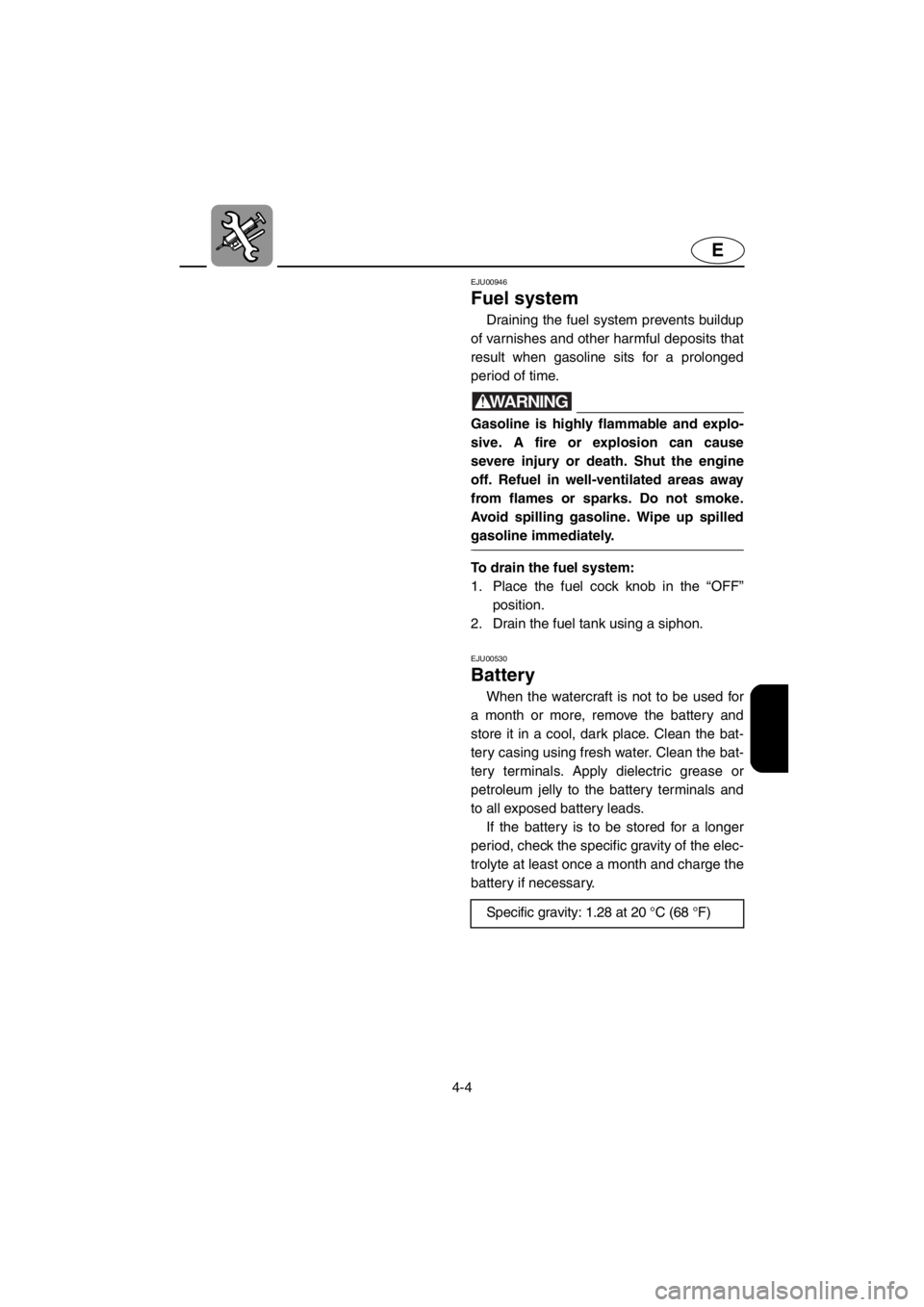
4-4
E
EJU00946
Fuel system
Draining the fuel system prevents buildup
of varnishes and other harmful deposits that
result when gasoline sits for a prolonged
period of time.
WARNING@Gasoline is highly flammable and explo-
sive. A fire or explosion can cause
severe injury or death. Shut the engine
off. Refuel in well-ventilated areas away
from flames or sparks. Do not smoke.
Avoid spilling gasoline. Wipe up spilled
gasoline immediately.
@
To drain the fuel system:
1. Place the fuel cock knob in the “OFF”
position.
2. Drain the fuel tank using a siphon.
EJU00530
Battery
When the watercraft is not to be used for
a month or more, remove the battery and
store it in a cool, dark place. Clean the bat-
tery casing using fresh water. Clean the bat-
tery terminals. Apply dielectric grease or
petroleum jelly to the battery terminals and
to all exposed battery leads.
If the battery is to be stored for a longer
period, check the specific gravity of the elec-
trolyte at least once a month and charge the
battery if necessary.
Specific gravity: 1.28 at 20 °C (68 °F)
E_GU5-71-4.fm Page 4 Thursday, July 13, 2000 7:54 PM
Page 100 of 135

4-5
E
EJU00531
Cleaning the watercraft
Clean the watercraft before storing for a
long period.
1. Wash down the hull, handlebars, and
drive unit with fresh water.
2. Rinse the engine and bilge area with
fresh water. Drain off all water and wipe
up remaining moisture with clean, dry
rags.
3. Spray the engine’s exterior with a rust
inhibitor and lubricant.
4. Wax the hull with a non-abrasive wax.
5. Wipe all vinyl and rubber components,
such as the seat and engine compart-
ment seals, with a vinyl protectant.
E_GU5-71-4.fm Page 5 Thursday, July 13, 2000 7:54 PM